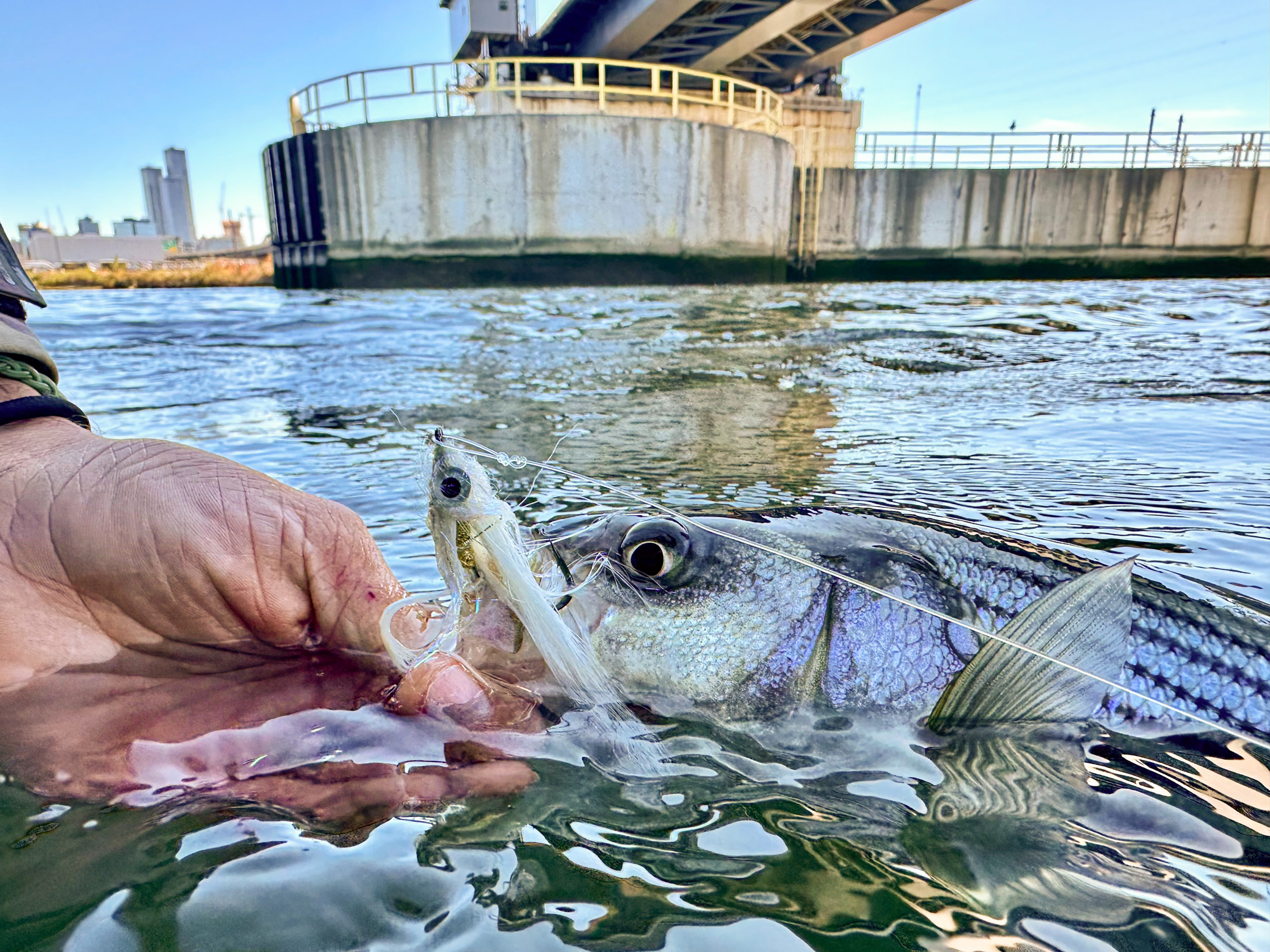Solitude in nature. It’s one of the many reasons we fish. We’ll hike a little farther, climb a little higher, and burn a little more boat fuel to get as far away from other people and the sights and sounds of everyday life. Even if the best we can do is a (mildly) quieter park in the busy suburbs, we’ll take it. Fishing is so often our reason to “get out” that it’s easy to overlook opportunities for great action — and yes, even solitude — in some of the most urban environments in the country.
I was recently invited to fish with Captain Zach Flake in the shadow of Manhattan on the New Jersey side of the Hudson River. For 12 years of my life, I commuted to the city for work, and every day on the train I looked out at the vast marshes, flowing tidal rivers, and creeks in what is the most densely populated part of my home state. The New Jersey Meadowlands are not pretty. They are chock full of industrial buildings, railroad bridges, seas of shipping containers, and intricate networks of highway interchanges. But I still always wondered what was swimming in those waters. I found reaffirmation that sometimes it’s worth running toward the rust and concrete instead of away.
Less Pressure

What struck me immediately when I met Flake at a very well-maintained public boat ramp in Secaucus, New Jersey, was that there was only one other boat launching. Mind you, this was a Saturday during peak fall striped bass season — jog 30 miles east to the coast and every ramp would be a zoo. What we tend to forget is that while there are more people in cities than out in the mountains, fewer of the people in the heart of concrete jungles are anglers. Flake had a milk run of spots in the Hackensack River and wasn’t concerned about being beaten to any of them.
Read Next: Fishing for Giant Blue Catfish in the Shadow of Capitol Hill
I’d witnessed the same lack of pressure years earlier fishing for peacock bass in Miami. The cacophony of commercial planes taking off over our heads, hip-hop and Cuban music blaring from open car windows, and the drone of the clogged highways were all present, though they seemed to melt away when you focused on the fishing. Not once throughout the day did we see another boat in the same waters. Of course, what good is a lack of pressure if there are no fish to catch? This brings us to the biggest myth about urban angling.
Is Anybody Home?
Thanks to so many changes in environmental law, a lot of waterways that cut through major cities are cleaner than they’ve ever been. Still, the notion persists that they’re largely void of life compared to surrounding “cleaner” water. The Hackensack River where I fished with Flake is a prime example of why that’s wrong.
Read Next: The Best Bass Lures
Historically it was very polluted. It’s still not perfect, but it’s far better than it was years ago. It’s also a tidal system, drawing clean saltwater in and flushing it back out several times a day. All that manmade structure — the bridge pilings, bulkheads, piers, and rock walls — creates current breaks and depth variation. It is not only attractive to large migrating stripers, but a great rearing ground and over-winter habitat for smaller ones. All morning, we cast flies against concrete rubble, old, collapsed wooden docks, and banks strewn with everything from office chairs to soggy mattresses. And on cast after cast, we got hammered by stripers. In an odd way, I found the merging of the natural world with the manmade peaceful, but this was certainly not the only place you can find this different style of solitude.

Great Cities for Urban Fishing
I’ve never shied away from fishing big cities, and over the last 20 years, I’ve met some great anglers who spend most of their time in these less-than-natural settings. If you’re looking to give urban angling a try, consider some of my favorite locations.
- New York, New York – People forget that the Big Apple is surrounded by saltwater on all sides. Twice a year, migrating brutes like striped bass and bluefish swim right past the Manhattan skyline and the fishing is world-class.
- Pittsburgh, Pennsylvania – The Ohio, Monongahela, and Allegheny Rivers all come together right downtown. Though there are plenty of species to target, the flathead catfishing is outstanding. I’ve caught monsters under the glow of Three Rivers Stadium during a Pirates game.
- Miami, Florida – A vast network of freshwater canals crisscross this city, providing what feel like endless miles of foot and boat access. Exotic species like peacock bass, knifefish, and snakeheads are all in play, but you’ll also find staples like largemouth bass, snook, and even small tarpon.
- Milwaukee, Wisconsin – Between the massive brown trout in the harbor and the steelhead running through downtown rivers, Milwaukee might be the “troutiest” city in the U.S. Add in a run of salmon from Lake Michigan and you’ve got urban angling paradise.

